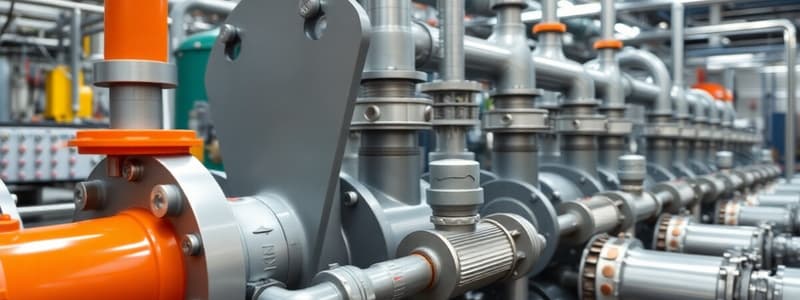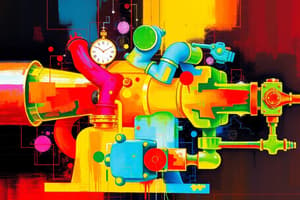Podcast
Questions and Answers
What is the purpose of compressing vapor ethylene in the process described?
What is the purpose of compressing vapor ethylene in the process described?
The purpose is to achieve the high pressure required for feeding into reactors.
How does the system prevent overheating of the vapor ethylene during compression?
How does the system prevent overheating of the vapor ethylene during compression?
The vapor ethylene is cooled by cooling water in the shell side of the Charge Gas Interstage Coolers.
What is the role of the Charge Gas Interstage K.O. Drums in the process?
What is the role of the Charge Gas Interstage K.O. Drums in the process?
They separate trace heavier components from the vapor ethylene.
What happens to the vapor ethylene after it passes through the second stage of the Charge Gas Compressors?
What happens to the vapor ethylene after it passes through the second stage of the Charge Gas Compressors?
What is the significance of cooling the vapor ethylene before it enters the second stage of compression?
What is the significance of cooling the vapor ethylene before it enters the second stage of compression?
Flashcards are hidden until you start studying
Study Notes
Compression Process Overview
- Vapor ethylene is compressed to high pressure for reactor feeding.
- The compression starts at D-110 (Charge Gas Compressor Suction Drum) where vapor ethylene is collected.
Charge Gas Compressors
- Ethylene is routed to the 1st Stage of C-120A/B (Charge Gas Compressors).
- The process involves multiple suction bottles:
- Entering D-121A/B-1 and D-121A/B-2 (1st Stage Suction Bottles).
- After compression, the gas moves to discharge bottles:
- Exiting through D-121A/B-3 and D-121A/B-4 (1st Stage Discharge Bottles).
Heat Management
- Compression causes vapor ethylene to heat up significantly.
- To maintain a constant 2nd stage temperature and remove heat, the vapor is sent to E-120A/B (Charge Gas Interstage Coolers).
- Cooling is achieved via water on the tube side, enhancing compressor efficiency by reducing required horsepower.
Separation of Heavier Components
- The cooled vapor ethylene is sent to D-120A/B (Charge Gas Interstage K.O. Drums).
- Here, trace heavier components are separated and routed to T-340 (Caustic Wash Vapor Scrubber) from the bottom of the drums.
Second Stage Compression
- Vapor ethylene proceeds from the overhead of D-120A/B to the 2nd Stage of C-120A/B.
- This involves additional suction and discharge bottling:
- Entering D-121A/B-5 and D-121A/B-6 (2nd Stage Suction Bottles).
- After compression, exiting through D-121A/B-7 and D-121A/B-8 (2nd Stage Discharge Bottles).
Final Stages and Reactor Feed
- The output from the 2nd stage is at sufficient pressure for feeding into R-201-205 (Reactors).
- The entire process aims to ensure efficient compression and heat management for optimal reactor operation.
Studying That Suits You
Use AI to generate personalized quizzes and flashcards to suit your learning preferences.

